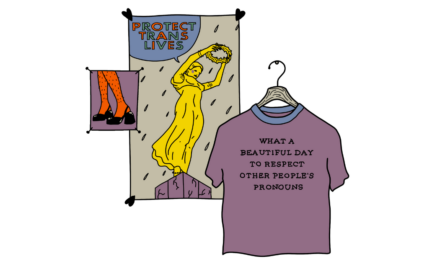
© Illustration Dunia Ciuferri
Would you like to have a glimpse into the everyday life of STI clinics* from the point of view of health care professionals? We diagnose, treat and prevent infectious diseases like HIV, syphilis, mpox and chlamydia. We engage with many individuals from different origins and backgrounds, but “men having sex with men” (MSM) remain our most faithful customers.
The job is colourful and ever-changing, with new and old diseases, treatments and prevention tools regularly popping up. We must adapt and implement strategies to fight these health challenges. Nonetheless, some things don’t change over time: there are still too many new HIV infections, condoms continue to be highly effective to prevent STIs, and diverse rectal objects still need surgical extractions. Trust me: commercial butt plugs are way better!
Some diseases seem to be winning. Syphilis, for example, is on the rise again after nearly disappearing just before the 2000s. It’s imaginative and versatile: it loves all forms of condomless penetration. Mpox also adopts new strategies to promote itself, but the main recipe stays the same whether between MSM in Europe in 2022 or in the Congo in 2024: close skin or mucosal contact. I support the WHO’s decision to change the name “monkeypox” to mpox because any form of discrimination should be well recognized and banned. Stigma remains one of the main reasons why STIs are so difficult to treat.
It’s equally difficult to recruit healthcare professionals for STI clinics as the job requires technical expertise, an open mind about sexuality and communication skills. No one is spontaneously at ease to care for rape survivors and professionals are continuously learning to identify the best approaches. Confidentiality and discretion in STI care are even more important than in other branches of healthcare.
As healthcare professionals, we mostly use condoms for sex with an occasional partner. Therefore, we don’t intuitively see the reasons for other means like PrEP. In a hectic professional life, more sexual partners means more STIs and therefore additional workloads. Despite the recent surge in gonorrhoea, chlamydia and syphilis, we try to keep the same level of explanation, treatment and contact tracing. But in reality, the growing number of cases makes it increasingly difficult to uphold the quality of care, which can lead to a negative perception of promiscuity.
As members of the queer community, we must continue advocating for a positive perception of sexualities. For example, it is crucial to promote sex as a vital component of mental and physical health, an integral part of our identities or even as a form of art. In this pursuit, let’s not forget sex workers who often have difficulties to speak out because of the law, and for whom access to good health services is even more important to earn money and stay safe.
Should we give up the fight simply because treated HIV is no longer lethal? Because bacterial STIs can be easily cured with antibiotics? I would argue we should not, as these conditions remain significant sources of illness, mental distress and stigma. Mpox has killed some members of our community in 2022. The current global sexual network creates a fertile ground for potential future epidemics.
Despite the risk of making my job useless, I still wish for a reduction of sexually transmitted infections simply because good health is vital. But is good health more important than sexual freedom? Being both a member of the queer community and a healthcare professional, I find myself sometimes squeezed between differing viewpoints on sex, freedom and health. Would it be useful to discuss boundaries?
If we add mental health to the picture, observations from the STI clinic can be worrisome. Note of caution: our professional lens is somehow distorted by contact with disease and these impressions don’t represent queer communities as a whole. However, loneliness, self-harm, low trust among peers, low self-esteem and stigma around infectious diseases frequently accompany our patients during their visits. These issues need awareness and attention from everyone, not only mental health professionals. The queer community can help a lot in this regard as well, while dating apps can’t. Their business model is based on keeping users stuck on the app for a long time instead of helping them find good matches in real life. We deserve better!
Promoting good netiquette on dating apps would be a good starting point, imagining real people and real feelings behind descriptions and nudes. Tolerance, time and curiosity can be useful tools for good sex as we don’t have intercourse with a copy of ourselves. While some fantasies are worth a try, others may be more powerful remaining fantasies. Most often we can tell the difference only through experience, which can be both funny or painful. Nevertheless, engaging with different partners without using condoms is still high-risk behaviour for catching STIs.
Although looking into risk management isn’t sexy at all, it may give us a fresh perspective on STI prevention. After all, professionals in fields like traffic, electricity or construction use protective equipment, insurance, teamwork, training, communication, guidelines and detailed protocols to avoid accidents. They don’t shy away from taboos if it saves lives. What could we learn from them to address community health challenges? Low-probability and high-consequence risks are difficult to manage in every field. For instance, planes don’t crash daily, but everyone complains about waiting in airport security lines. In the “low-probability and high-consequence” risk category, I would put HIV (as it’s still not curable, thus having a lifelong impact), mpox (mostly curable, but sometimes requiring hospitalisation and occasionally fatal) and new infections, that science has yet to identify.
Do you fancy tackling an unsolved community health riddle? Here it is. Unfortunately, we still can’t see the efficacy of oral PrEP on new HIV infections in Luxembourg (have a look at the graph). Despite gay men being early adopters of PrEP since 2017. Despite PrEP being very efficient on an individual level. What are the reasons? Is it too early to expect results? Do we use it in high-risk situations? Would it be worse if PrEP were not available? Is it too difficult to access or use correctly? Would injectable PrEP change the situation? Is it too expensive and taboo for broader society to support individuals with the highest risk behaviours? Let me know how you would resolve these contradictions.
I believe in community action: we shape our spaces according to our ideas. Why wait for education professionals to teach about gender diversity or STI prevention? We can do it ourselves. Why tolerate Grindr‘s half-hearted healthcare messages and safety recommendations? We can choose to boycott. We can crowdsource alternatives. Why keep carrying the stigma about sexuality and STIs? We can choose to speak out. Why blame governments for not doing enough for queer communities? We also can sit together, discuss the options, plan the actions, and choose the most efficient and respectful for everyone. We deserve better!
Anna T has asked “What sort of queer landscape will we create?” in the spring 2024 edition of queer.lu, in her piece “Queer Promiscuity: Liberating or Hindering?”. You haven’t read it yet? It’s brilliant and available online via queer.lu. She explores among other subjects the progress made in sexual freedoms from the mental health professional’s point of view.
As you have guessed my dreams aren’t fairytale utopias either, but more akin to a political program. Unfortunately, freedoms come with rules and rights come with obligations. No easy questions, no easy answers, but worth the discussion because we are living in a time where change is possible.
Defending freedoms, and creating LGBTQIA+ zones is great progress, but what limits do we want or need to give them to be truly operational? Which recommendations to prefer for the benefit of the community? What can we learn from past epidemics to prevent the next ones? It would be better to create the rules within the community, but it is hard work. For example, during the 2022 mpox outbreak, we needed the WHO to step in to recommend temporarily reducing the number of sexual partners to fight the epidemic.
In my vision, a solid queer community should be able, after careful discussion and weighing alternatives, to produce a set of common values and rules that are worth living for. These guidelines could as well help us to integrate more fully into broader society and set safer grounds for future queer generations.
*STI clinics: health centres for Sexually Transmitted Infections (STIs):
- CHL, Centre Hospitalier de Luxembourg (screening and treatment): www.chl.lu/fr/service/maladies-infectieuses
- Croix-Rouge, HIV-Berodung DIMPS (mobile clinics and screening): www.croix-rouge.lu/en/service/hiv-berodung-prevention-testing-and-treatment/dimps/
- Planning familial (prevention, screening and treatment): https://pfl.lu/nos-centres/luxembourg/
- A new clinic at Cigale is in planning as well
If you’re interested in HIV epidemiology and community health actions in Luxembourg, have a look at the “Rapport du comité HIV 2023”




